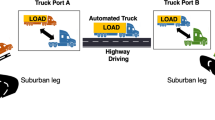Abstract
This study utilized telematics technology to automatically collect data that could then be used to improve striping performance without the need for additional staff or equipment. This paper presents the telematics data collection and implementation in two areas: (1) providing performance analyses using telematics data and (2) developing performance metrics for future performance measurement. Striping is a continuous maintenance operation for all roadway O&M managers and it requires substantial resources and financial investment if good or excellent striping condition is to be maintained. Striping mileage per day was used to represent productivity in this study. The average striping mileage in 2012 comprised only 15–25% of the total average driving miles per day. The utilization analysis indicated that centerline trucks were utilized at significantly higher levels than edgeline trucks, although the overall utilization ratio only ranged between 20 and 30%. Three levels of productivity metrics were developed from normal distribution probability density functions and appropriate parameters obtained from the Monte Carlo simulation results. Measured in terms of striping miles per day, low productivity was taken to be any value less than or equal to 30%, medium productivity any value more than 30% and less than or equal to 70%, and high productivity any value over 70%. As a result of the study, performance analyses revealed that there was sufficient room for improvement and several recommendations were made. Multiple operational scenarios reveal that productivity and utilization can be increased up to 47 percent while eliminating several striping trucks. Performance metrics were provided using Monte Carlo and triangular distribution.




Similar content being viewed by others
References
Navon R, Shpatnitsky Y (2005) Field experiments in automated monitoring of road construction. J Constr Eng Manage 131(4), 487–493
McCullouch B (1997) Automating field data collection in construction organizations. In: Proceedings, 5th construction congress: managing engineered construction in expanding global markets, ASCE, Reston, VA., 957–963
Cheok GS, Stone WC, Lipman RR, Witzgall C (2000) Ladars for construction assessment and update. Autom Constr 9(5–6):463–477
Futcher K (2001) User survey on a WAN portfolio MIS used for portfolio/project management in Hong Kong. In: Proceedings, IT in construction in Africa, W78 Workshop, White River, South Africa, 44-1-44–14
Saidi KS, Lytle AM, Stone WC (2003) Report of the NIST Workshop on data exchange standards at the construction job site. In: Proceedings, ISARC-20th international symposiums on automation and robotics in construction, van Gassel F (ed) Eindhoven, The Netherlands, 617–622
Sacks R, Navon R, Brodetskaia I, Shapira A (2005) Feasibility of automated monitoring of lifting equipment in support of project control. J Constr Eng Manage 131(5):604–614
Cheng X, Dong J, Han X, Fei Q (2016) Structural health monitoring-oriented finite-element model for a larger transmission tower. Int J Civ Eng. doi:10.1007/s40999-016-0069-3
Bosurgi, Bongiorno, Pellegrino (2014) A nonlinear model to predict driver track paths along a curve”. Int J Civ Eng 14(5):271–280
Oral EL, Oral M, Andaç M (2016) Construction crew productivity prediction: application of two novel methods. Int J Civ Eng 14(13):181–186. doi:10.1007/s40999-016-0009-2
Dunn WL, Shultis J (2012) Exploring Monte Carlo methods. Elsevier/Academic Press, Amsterdam
Kalos MH, Whitlock PA (2008) Monte Carlo Methods. Second revised and enlarge ed., Wiley, New York, NY
L’Écuyer P, Owen AB (2009) Monte Carlo and quasi-Monte Carlo methods 2008. Springer, Heidelberg, NY
Driels MR, Shin ÝS (2004) Determining the number of iterations for Monte Carlo simulations of weapon effectiveness, Naval Post-graduate School, Monterey, CA
Williams TM (1992) Practical use of distributions in network analysis. J Oper Res Soc 43:265–270
Forbes C, Evans M, Hastings N, Peacock B (2010). Triangular Distribution, in Statistical Distributions. Statistical Distributions, Fourth Edition, Wiley, Hoboken, N.J., 189–190
Author information
Authors and Affiliations
Corresponding author
Rights and permissions
About this article
Cite this article
Koo, D.D., Jung, Y. & Campos, U. Performance Analysis and Metrics Development for Roadway Striping Operation Using Telematics Technology. Int J Civ Eng 15, 827–838 (2017). https://doi.org/10.1007/s40999-017-0198-3
Received:
Revised:
Accepted:
Published:
Issue Date:
DOI: https://doi.org/10.1007/s40999-017-0198-3




